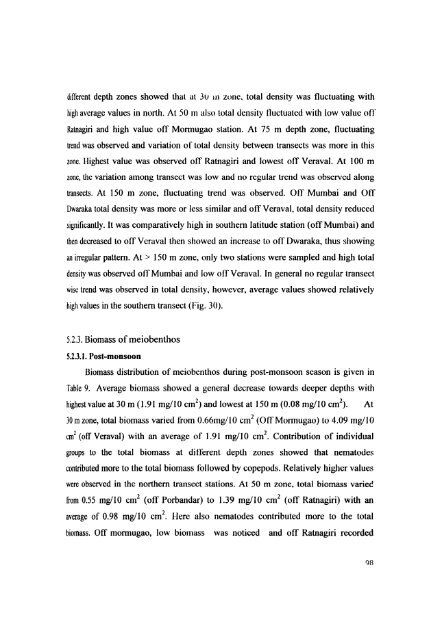L - Cochin University of Science and Technology
L - Cochin University of Science and Technology
L - Cochin University of Science and Technology
Create successful ePaper yourself
Turn your PDF publications into a flip-book with our unique Google optimized e-Paper software.
different depth zones showed that at 3v lJl zone. total density was fluctuating with<br />
high average values in north. At 50 m also total density fluctuated with low value <strong>of</strong>f<br />
Ratnagiri <strong>and</strong> high value <strong>of</strong>f Monnugao station. At 75 m depth zone, fluctuating<br />
trend was observed <strong>and</strong> variation <strong>of</strong> total density between transects was more in this<br />
zone. Highest value was observed <strong>of</strong>f Ratnagiri <strong>and</strong> lowest <strong>of</strong>f Veraval. At 100 m<br />
lone, the variation among transect was low <strong>and</strong> no regular trend was observed along<br />
transects. At 150 m zone, fluctuating trend was observed. Off Mumbai <strong>and</strong> Off<br />
Dwaraka total density was more or less similar <strong>and</strong> <strong>of</strong>f Veraval, total density reduced<br />
significantly. It was comparatively high in southern latitude station (<strong>of</strong>f Mumbai) <strong>and</strong><br />
then decreased to <strong>of</strong>f Veraval then showed an increase to <strong>of</strong>f Dwaraka, thus showing<br />
an irregular pattern. At > 150 m zone, only two stations were sampled <strong>and</strong> high total<br />
density was observed <strong>of</strong>f Mumbai <strong>and</strong> low <strong>of</strong>f Veraval. In general no regular transect<br />
wise trend was observed in total density. however, average values showed relatively<br />
high values in the southern transect (Fig. 30).<br />
5.2.3. Biomass <strong>of</strong> meiobenthos<br />
5.2.3.1. Post-monsoon<br />
Biomass distribution <strong>of</strong> meiobenthos during post-monsoon season is given in<br />
Table 9. Average biomass showed a general decrease towards deeper depths with<br />
highest value at 30 m (1.91 mg/IO cm 2 ) <strong>and</strong> lowest at 150 m (0.08 mg/IO cm 2 ). At<br />
30 m lone, total biomass varied from 0.66mg/1O cm 2 (Off Monnugao) to 4.09 mg/IO<br />
cm 2 (<strong>of</strong>f Veraval) with an average <strong>of</strong> 1.91 mg/IO cm 2 • Contribution <strong>of</strong> individual<br />
groups to the total biomass at different depth zones showed that nematodes<br />
contributed more to the total biomass followed by copepods. Relatively higher values<br />
were observed in the northern transect stations. At 50 m zone, total biomass variec<br />
from 0.55 mgllO cm 2 (<strong>of</strong>f Porb<strong>and</strong>ar) to 1.39 mg/lO cm 2 (<strong>of</strong>f Ratnagiri) with an<br />
average <strong>of</strong> 0.98 mg/lO cm 2 • Here also nematodes contributed more to the total<br />
biomass. Off monnugao, low biomass was noticed <strong>and</strong> <strong>of</strong>f Ratnagiri recorded<br />
98

















